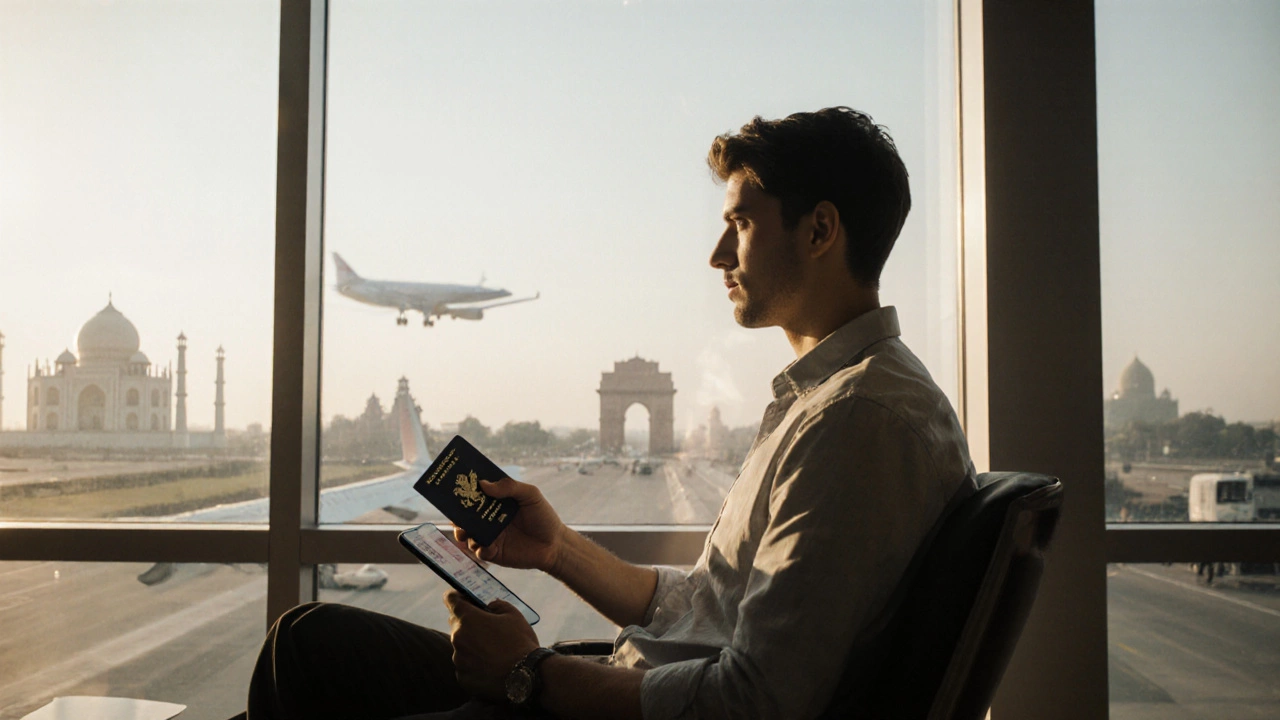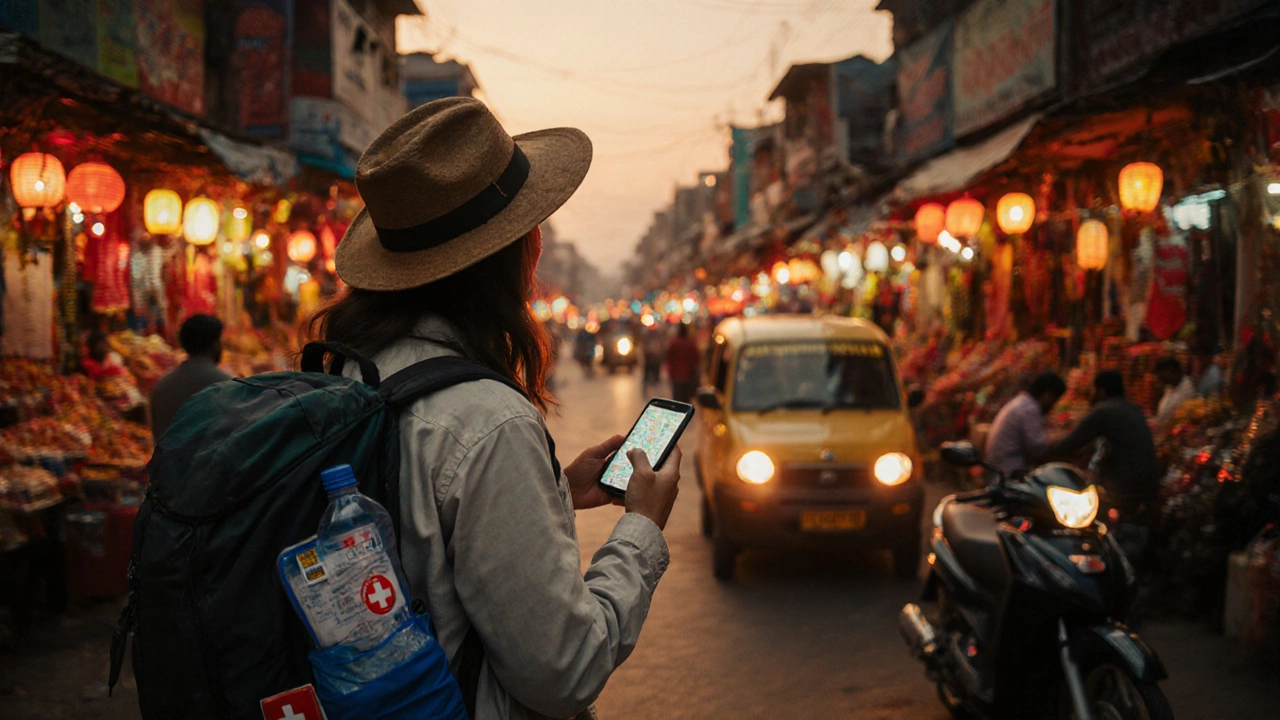Is it Safe to Travel to India Right Now? 2025 Safety Guide
 Oct, 9 2025
Oct, 9 2025
India Travel Safety Checker
Safety Profile for Selected Region
North India
Crime Index: 3 / 5
Health Risks: Low (mostly food-borne)
Recent Incidents: Minor protest disruptions in Delhi
Overall Score: 4.0South India
Crime Index: 2 / 5
Health Risks: Medium (dengue during monsoon)
Recent Incidents: No major security events
Overall Score: 4.2East India
Crime Index: 3 / 5
Health Risks: High (malaria in forest belts)
Recent Incidents: Isolated flood-related road closures
Overall Score: 3.5West India
Crime Index: 2 / 5
Health Risks: Low (urban settings)
Recent Incidents: Occasional pickpocket reports in Mumbai
Overall Score: 4.3Northeast India
Crime Index: 4 / 5
Health Risks: Medium (terrain-related injuries)
Recent Incidents: Localized ethnic unrest in Assam (brief)
Overall Score: 3.8Thinking about hopping on a flight to India but wondering if it’s a good idea right now? You’re not alone - safety is the first thing most travelers check before booking a ticket. This guide pulls together the latest data, government warnings, health alerts, and on‑the‑ground tips so you can decide with confidence.
What the Numbers Say Today
As of October2025, India welcomes roughly 10million foreign tourists a month, a 12% rise from 2024. The World Travel & Tourism Council reports that the overall crime index for tourist‑heavy zones sits at 38/100 - lower than many popular European capitals. However, health‑related incidents (mostly food‑borne and vector‑borne diseases) account for about 4% of all visitor emergencies, according to the Ministry of Health’s latest bulletin.
In short, the country is bustling, the big‑city crime risk is modest, and the main health concerns are manageable with the right prep.
Government Travel Advisories
Most western governments publish real‑time alerts. Below is a snapshot of the major ones as of early October2025:
- United States Department of State: Level2 - “Exercise increased caution” in the states of UttarPradesh, Bihar, and parts of the Northeast due to sporadic protests.
- United Kingdom Foreign Office: Level2 - similar caution, with added advice to register with the British High Commission in NewDelhi.
- NewZealand Ministry of Foreign Affairs and Trade: Level2 - “Exercise normal safety precautions,” emphasizing weather‑related disruptions in the Himalayan region during monsoon.
All three agencies agree that the major tourist corridors - Delhi, Mumbai, Bangalore, Chennai, and Goa - remain safe for standard travel, provided you stay aware of local news and follow basic security habits.
Health Landscape: COVID‑19 and Beyond
COVID‑19 cases in India have dropped to under 5per100000 people, and the government has lifted all entry testing requirements for vaccinated travelers. Still, the Ministry of Health recommends a negative RT‑PCR test within 72hours if you’re coming from a high‑risk country.
Other health risks to consider:
- Dengue and Chikungunya - prevalent during the monsoon (June‑September). Carry insect repellent and wear long sleeves after dusk.
- Malaria - still a concern in forested zones of Odisha, Jharkhand, and the Western Ghats. A short course of prophylaxis is advised if you’ll be in those areas for more than a week.
- Food‑borne illnesses - stick to bottled water, avoid raw salads, and eat at reputable restaurants.
Vaccinations you’ll want up to date: HepatitisA, Typhoid, Tetanus, and, for longer stays, Japanese Encephalitis when traveling to rural eastern states.
Regional Safety Snapshot
| Region | Crime Index (1‑5) | Health Risks | Recent Incidents | Overall Safety Score |
|---|---|---|---|---|
| North India | 3 | Low (mostly food‑borne) | Minor protest disruptions in Delhi | 4.0 |
| South India | 2 | Medium (dengue during monsoon) | No major security events | 4.2 |
| East India | 3 | High (malaria in forest belts) | Isolated flood‑related road closures | 3.5 |
| West India | 2 | Low (urban settings) | Occasional pickpocket reports in Mumbai | 4.3 |
| Northeast India | 4 | Medium (terrain‑related injuries) | Localized ethnic unrest in Assam (brief) | 3.8 |
These scores are a quick visual aid - they blend crime statistics from the National Crime Records Bureau with health alerts from the World Health Organization. Even the highest‑risk region (Northeast) still scores above 3.5, meaning a typical tourist can visit safely if they follow local guidance.
Practical Precautions Before You Go
- Get the recommended vaccinations at least two weeks before departure.
- Purchase a comprehensive travel insurance policy that covers medical evacuation, COVID‑19 re‑tests, and trip cancellation.
- Register your travel itinerary with your home‑country’s embassy or consulate - it speeds up assistance if something goes wrong.
- Download a reliable local news app (e.g., The Hindu) and enable push alerts for the cities you’ll visit.
- Carry a small day‑pack with a portable charger, a copy of your passport, and a basic first‑aid kit.
When you’re on the ground, keep these habits in mind: use only registered taxis (app‑based services like Uber or Ola are safest), avoid flashing valuables, and always ask locals or hotel staff about current crowd conditions before heading to popular sites.
When to Hold Off or Rethink Your Trip
If you’re planning to travel in the next few weeks, watch for these red flags:
- Sudden escalation of protests in Delhi or Mumbai - the government may impose curfews that limit movement.
- Extreme weather alerts, especially heavy monsoon flooding in the Western Ghats and the Brahmaputra basin.
- Any new travel bans or mandatory quarantine orders issued by your home country’s foreign office.
In those scenarios, postponing for a month or opting for a low‑risk region (like the coastal parts of Kerala) can save you hassle and money.

Quick Safety Checklist
- Check your government’s travel advisory level for India.
- Update vaccinations (HepA, Typhoid, COVID‑19 booster).
- Buy travel insurance that includes health evacuation.
- Pack insect repellent and a water‑purification method.
- Keep digital and printed copies of important documents.
- Download a reliable offline map of the city you’ll stay in.
- Stay connected - buy a local SIM or enable international roaming.
Follow this list and you’ll cover the biggest safety bases before you board that flight.
Is it safe? Bottom line
If you’re looking for a travel to India safety answer, the short version is: yes, it’s generally safe for tourists in 2025, especially in the major cities and well‑touristed regions. The key is to stay informed, get the right shots, and take sensible precautions.
Frequently Asked Questions
Do I need a COVID‑19 test to enter India?
As of October2025, fully vaccinated travelers from low‑risk countries do not need a pre‑departure PCR test. If you’re unvaccinated or coming from a high‑risk area, a negative RT‑PCR taken within 72hours is required.
Which Indian states are safest for solo female travelers?
Kerala, Goa, and the hill stations of Himachal Pradesh (e.g.,Manali) consistently rank high for safety, with low crime rates and supportive local tourism offices. Always use reputable accommodations and transport services.
What health insurance should I buy for an Indian trip?
Choose a plan that covers emergency medical evacuation, COVID‑19 related care, and treatment for vector‑borne diseases like dengue. Policies that include a 24‑hour helpline in the local language are especially helpful.
Are there any areas I should completely avoid?
Border regions in Jammu & Kashmir (especially the Line of Control) and parts of the far‑east (Manipur) can experience sudden unrest. Check the latest advisory before booking anything there.
What’s the best way to stay safe on public transport?
Opt for app‑based rides (Uber, Ola) rather than hailing a random auto‑rickshaw. If you use trains, keep your luggage close, avoid empty compartments at night, and carry a small lock for your bag.